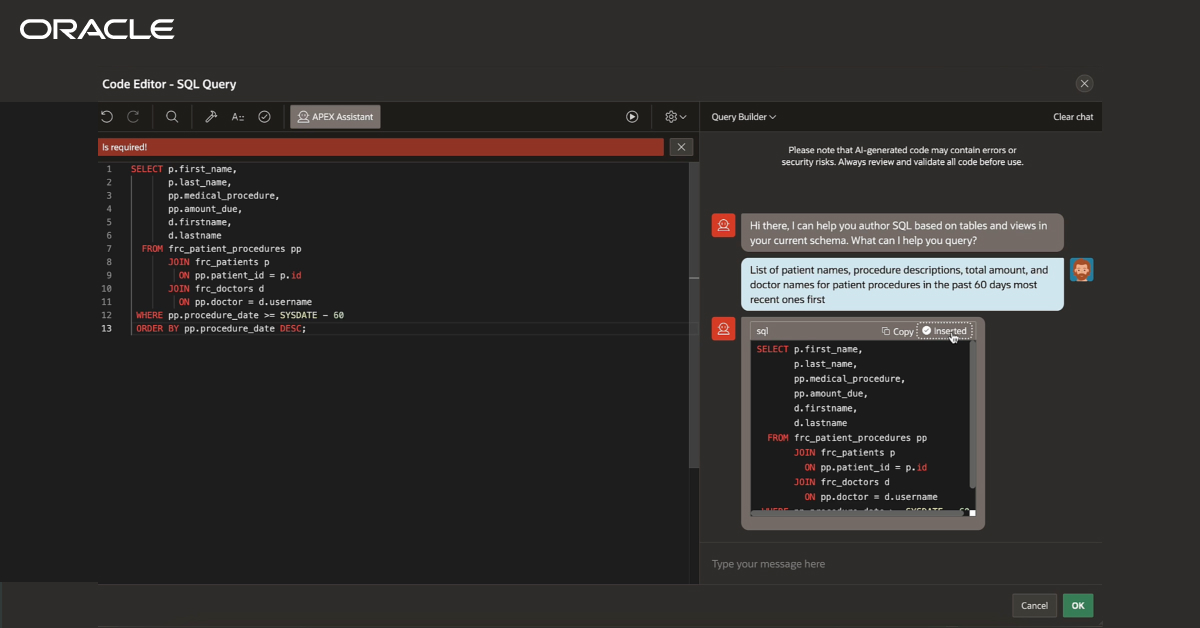
Last week Oracle announced the availability of version 24.1 of its APEX low-code platform. A new version makes sense to complement Oracle Database 23ai that was announced in May. (Look for more on Oracle Database in an upcoming analysis from my colleague Robert Kramer.) That said, there is a lot more to this release than just the database, and Oracle has put forward a perspective on low-code platforms that changed my perception of low-code in general.
If you are an Oracle customer, APEX is worth a look, especially since it comes for free with Oracle Database. If you aren’t a customer, Oracle paints a picture of an AI-inflected approach that may be different from your current perceptions of low-code and where it could go.
Of Course APEX Has Generative AI
Like seemingly every other development tool and platform announced this year, APEX includes generative AI features to assist developers. However, Oracle has taken a different approach to how it implements GenAI here. First, it is independent from any specific LLM. So, you can effectively point APEX at whatever you like. Many other developer platforms support just one or two LLMs, so this is an interesting capability for a couple of reasons. First, as AI is deployed more in enterprises, a degree of flexibility may make adoption easier. Second, as a European colleague pointed out to me recently, some LLMs perform differently with different languages. So, for example, an application in Spanish might perform better using a different model.
On the UI front, Oracle has gone beyond the ubiquitous chat box where you enter your prompt—and hope you remember everything you needed to tell the LLM. APEX includes form-like interface windows where the decisions or configurations you make direct what is included in your LLM prompt. I found this to be a better way to guide the overall experience than a simple chat box would be. In the long run, I could see enterprises using those forms to manage policies or security (more on that in a bit). I’d say that APEX represents an evolved view of an AI-driven developer experience.
Generative AI Is Only Part of the Story
While GenAI is a hot topic, APEX has a lot more to offer in this release. For example, there is a new capability that allows developers to create application workflows and embed approvals as well as status monitoring. There are also new capabilities for paper-based workflows with pixel-perfect form generators. Both of these are borrowed from other Oracle Cloud Infrastructure services (and therefore may come with an additional cost).
However, APEX’s biggest non-GenAI features leverage the new capabilities of Oracle Database 23ai. For example, there is a transformer capability that translates SQL into vector commands. This allows developers without machine learning skills to reference assets within the database and perform machine learning functions upon them. Consider a picture lookup that summarizes the picture automatically. Another feature that is not GenAI-specific but still AI-related is how the product documentation was created in a way that is easily readable by LLMs. It was nice to see that Oracle was more thoughtful about leveraging the underlying database instead of just implementing an AI chatbot.
A Different Perspective on Productivity
As part of the launch, I was invited to a webconference with the APEX team, and that is where some of the more surprising insights came up. While most of us think of low-code as being for non-developers or line-of-business people, Oracle indicated that the deployment of and responsibility for low-code platforms is starting to shift to central IT.
Oracle’s underlying argument is that the industry’s representation of developer productivity is flawed. I agree with this sentiment. So many measures of AI-driven developer productivity have to do with increasing the speed of coding itself. However, developers and non-developers alike do a lot more than coding. During the webconference, there were three areas of developer productivity we discussed that could be enhanced by the use of a more robust low-code platform. These areas are all being contemplated for future versions of APEX. (Worth noting: Oracle’s contemplation of these does not equal a commitment or a timeframe for any of them.)
- Code maintainability and upgrades — My first rule of AI is that it’s only better when it takes low-grade work or drudgery off of our hands. And many developers like to create apps and write code. So the best-case scenario for a developer would be to automate the tasks they like doing the least—such as unit testing, upgrades, and other tech hygiene work. The APEX team is thinking about how to make it super easy to maintain and update code after it’s deployed. There are some serious challenges in making this work given how everyone’s development processes and pipelines are different, but AI may be able to help—if it’s given the right training.
- Smarter guardrails — The challenge with low-code platforms and their forebears (collaboration and document management apps, for instance) is that they are hard to manage. There are often situations of application sprawl or abandonment. That’s because these tools are typically focused on people who don’t fully understand the implications of what they are building. But if there were more effective guardrails to help recommend or prescribe which actions could be taken in a given situation, we might have a solution that meets IT governance requirements and is still easy to work with. Oracle has a number of ideas here, including some new technologies that they are testing internally now.
- New personas — Oracle has data that suggests that APEX is increasingly being used by both central IT and pro-code developers. The reason it’s being selected is higher productivity, because devs can build certain classes of apps faster using APEX. The Oracle team is trying to figure out what devs like these need in terms of features and operational requirements without crossing over to a pro-code toolset.
It’s hard for technology vendors to not catch the GenAI hype train right now. In fact, it could be damaging to their reputations if they ignored what AI can do. What’s nice about APEX is that it is balanced in terms of embodying an evolved AI experience as well as a clear, practical vision for where low-code can go.






















































































